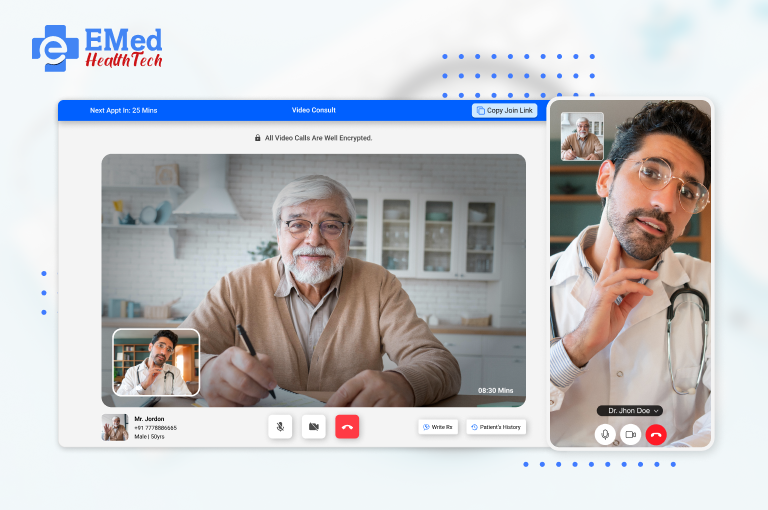Telemedicine has revolutionized healthcare by making remote meetings more open and productive. As more healthcare providers embrace virtual care, choosing a telemedicine platform becomes basic to guarantee consistent communication, administrative compliance, and improved patient experience.
Selecting telemedicine software isn’t just about video consultations—it’s almost integration, security, convenience, and adaptability. With different platforms accessible, finding the best telehealth solution requires a cautious assessment of key variables.
Key Considerations When Choosing a Telemedicine Platform
 1. Compliance and Security
1. Compliance and Security
Patient confidentiality is a topmost priority. The stage you select must comply with industry controls to defend delicate information. Explore for:
- HIPAA Compliance (for U.S. practices) or GDPR Compliance (for European suppliers)
- End-to-end encryption for video discussions and quiet records
- Multi-factor authentication (MFA) for secure logins
- Regular Program Updates to anticipate cybersecurity dangers
2. User Experience and Accessibility
It is essential to create a telemedicine platform that is user-friendly for doctors as well as for patients. The following are a few points to look for when choosing a telemedicine platform:
- Intuitive interface with easy navigation
- Compatibility with mobile, tablet, and desktop devices
- Quick onboarding and minimal learning curve
- Seamless appointment scheduling and patient check-ins
3. Integration with Existing Systems
Your telemedicine software should integrate seamlessly with:
- Electronic Health Records (EHR) helps access the medical history of the patient
- Practice Management Systems (PMS) streamline workflows
- Billing and Payment Gateways for insurance claims and patient transactions
A well-integrated platform reduces administrative burdens and improves efficiency.
Essential Features of the Best Telehealth Solutions
Not all the best telemedicine solutions offer the same capabilities. The best platforms provide:

- HD Video & Audio Quality – Ensures smooth and professional virtual consultations
- Screen Sharing & File Uploads – Facilitates better diagnosis with medical images and documents
- Automated Scheduling & Reminders – Reduces no-shows with SMS and email notifications
- Multi-User Support – Enables group consultations and specialist collaborations
- Customizable Features – Tailored templates and functionalities for different specialities
A platform with these highlights upgrades patient engagement, streamlines operations, and progresses healthcare results.
Evaluating the Right Fit for Your Practice
Distinctive healthcare providers have interesting needs, and choosing a telemedicine platform ought to be based on practice estimates and specialization.
Small vs. Large Practices
- Small clinics: Need affordable, easy-to-use platforms with basic functionalities.
- Larger healthcare organizations: Require multi-provider support, scalability, and full EHR integration.
Specialty-Specific Requirements
- Mental Health Providers: Require secure messaging, therapy note-taking, and video session recording.
- Dermatologists: Need high-resolution image uploads for remote diagnosis.
- Primary Care Physicians: Benefit from lab integration for sharing test results digitally.
Scalability for Future Growth
When choosing a telemedicine platform, one should support the practice’s future expansion by:
- Accommodating growing patient volumes
- Enabling multiple healthcare providers to join the platform
- Offering customizable workflows as your practice evolves
Cost Considerations: Finding the Right Balance
Investing in telemedicine software involves different pricing models. Consider:

- Subscription-Based Pricing: Monthly or yearly plans covering various features
- Pay-Per-Use Model: Costs depend on the number of consultations conducted
- Hidden Fees: Be careful for additional charges related to information storage, integrative, or client support
While upfront costs could appear tall, the long-term benefits exceed the investment—higher income, improved patient retention, and operational productivity.
Customer Support and Training
Adopting a telemedicine platform requires proper training and ongoing technical support. Before finalizing your choice, ensure the provider offers:
- 24/7 Customer Support for quick resolution of technical issues
- Training Sessions for healthcare staff and onboarding assistance for patients
- Troubleshooting Guides & Help Centers for self-service support
A responsive support team ensures smooth operations and minimizes disruptions to patient care.
Conclusion: Making an Informed Choice
Choosing the right telemedicine platform is vital for progressing patient encounters, streamlining workflows, and keeping up administrative compliance. By assessing compliance, integration, security, client involvement, and cost, healthcare providers can discover the best telehealth solution for their practices.
Why Choose EMed HealthTech?
For a secure, versatile, and feature-rich telemedicine solution, EMed HealthTech gives cutting-edge innovation outlined for cutting-edge healthcare experts. With consistent EHR integration, vigorous security, and user-friendly interfacing, EMed HealthTech helps practices convey predominant virtual care with confidence.
Contact EMed HealthTech today and take your telemedicine services to the next level!











